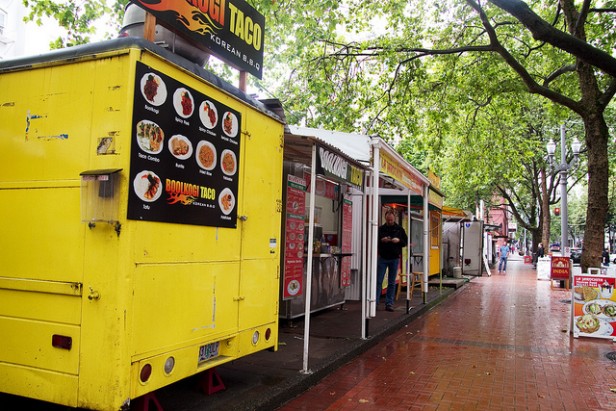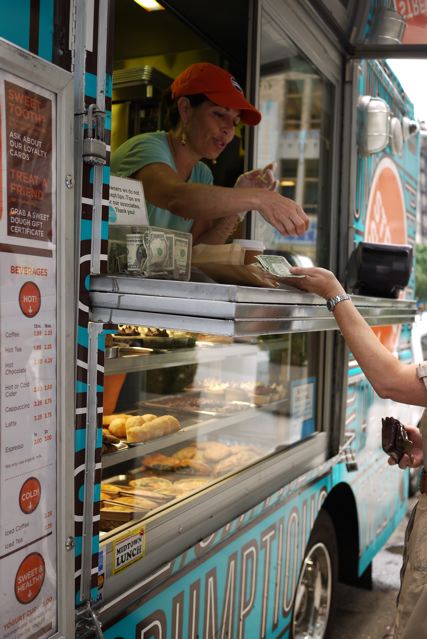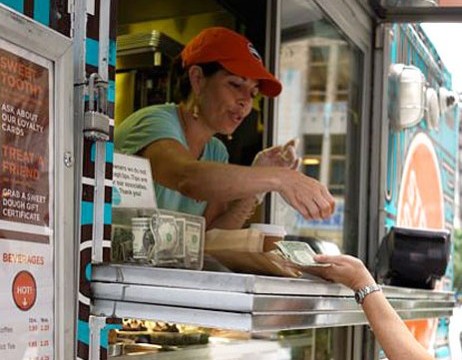 Portland’s thriving food-truck scene is a destination in its own right. Photo courtesy Roboppy via Flickr
Portland’s thriving food-truck scene is a destination in its own right. Photo courtesy Roboppy via Flickr
A New York minute is understood to be the interval of time between a Manhattan traffic light turning green and the guy in the car behind you honking his horn.
Lately it’s also enough time for a hungry Manhattanite to get a substantial grass-fed beef hamburger, sourced straight from the La Cense ranch in Montana to its New York “Beef Burger Truck”; an iced, rainforest-friendly coffee from the Street Sweets truck, served up in a clear but biodegradable cup; or a cone of whole-bean vanilla ice cream made from hormone-free dairy and pure cane sugar, from the Van Leeuwen Ice Cream truck. And still have change left over from a $20.
They’re part of a new wave of Net-savvy street food vendors across the country who are transporting the Slow Food movement’s embrace of local, sustainably-grown, and uncommonly delicious ingredients beyond the confines of pricey restaurants into the nation’s coast-to-coast love affair with street food. Call them the nouvelle food trucks.
Despite the grim state of the economy, urbanites are spending as much if not more of their food budgets on eating out than on cooking in. But rather than sit down to an expensive restaurant meal, upscale food trucks and carts have become go-to venues for quick, tasty meals. The nouvelle trucks are an even newer breed of mobile entrepreneurs, who specialize in whipping up relatively cheap fare that doesn’t require eaters to chuck their health — or their ethics — in the gutter.
Sweet tweets
To help build their brands, many nouvelle trucks use Facebook to build customer loyalty, and Twitter to broadcast their truck locations.
 Sweet Treats co-owner Samira Mahboubian dispenses change.Photo: Emily Gertz“Social networking — it’s essential, it creates a buzz,” says Grant di Mille, co-owner of Street Sweets with his wife, Samira Mahboubian.
Sweet Treats co-owner Samira Mahboubian dispenses change.Photo: Emily Gertz“Social networking — it’s essential, it creates a buzz,” says Grant di Mille, co-owner of Street Sweets with his wife, Samira Mahboubian.
It also creates business. Since “the police can at any time tell you that you need to move,” says Di Mille, “I can tweet that I’ve moved from 45th to 46th Street,” guiding thousands of hungry followers to their next fix of freshly made, all-natural whoopie pies, cookies, and croissants, as well as his truck’s signature locally-roasted, fair trade coffee.
A big social-media presence also leads to more catering jobs, he says — gigs that can be crucial to the bottom line for a food truck business, particularly one featuring expensive upscale ingredients.
Only a handful of “good food” trucks are driving around New York. It’s a different scene in Portland, Ore., recently rated the nation’s #1 street food city by CNN. There, more than 400 vendors vie for the hearts and mouths of greater Portland’s 2 million or so residents, as well as its influx of tourists.
Brett Burmeister, who owns, manages, and writes most of the blog foodcartsportland.com, says that while not every vendor touts an organic or sustainable ethos, environmental conscientiousness pervades his city’s street-food scene: “I’d say 90 percent [of the carts] are using biodegradable types of containers.” While Portland has banned Styrofoam containers, “you rarely even find the clear plastic clamshells,” he says.
The food cart boom has also benefited from the city’s long-time embrace of Oregon-grown and produced foods, says Burmeister. “All the weekend carts go to the farmers markets in the morning for their supplies.” And at least one stocks up hyper-locally: “YoGio, a Korean cart in north Portland, is getting vegetables from a local front-yard farmer,” he says, “a lady just down the street who is growing enough that they can get what they need.”
In the San Francisco Bay area, 80 street-food vendors will participate in the second annual Eat Real Festival, held in Oakland in late August. The event is dedicated to the idea “that delicious, convenient, affordable and sustainable food should be celebrated through an annual food festival,” says director Susan Coss. Vendors can charge no more than $5 per serving, and must include at least a few local ingredients in their dishes.
Although only 40 street food vendors participated in 2009’s inaugural fest, 70,000 people showed up to eat (organizers expected around 30,000). The carts took in around $300,000 over three days, and the event broke even on expenses in its first year.
“We were very lucky, the timing was perfect,” says Coss. In addition to the area’s longstanding enthusiasm for local, sustainable, and organic, “there was a big upsurge of interest in street food, it was new and hot. On top of that, the economy was horrible, and people weren’t paying to go anywhere [out of town].”
All of Eat Real’s vendors will be sourcing locally and sustainably — some because the festival requires it, others because their clientele like it.
Still other Bay Area nouvelle food trucks do it out of a personal commitment to helping build a better food system, one serving at a time. Take Let’s Be Frank, which sells grass-fed beef hot dogs from carts and trucks in San Francisco and Los Angeles.
For most of his former career managing high-end San Francisco restaurants, cofounder Larry Bain paid top dollar for prime cuts of grass-fed beef. But the ranchers told him they could not live on selling rib eye and filets alone: “Every cow has about 600 pounds of trim,” Bain says, “a significant amount of meat per cow” that gourmet restaurants don’t want.
Let’s Be Frank pays around $2.50 per pound for this high-quality beef trim, says Bain, compared to $1.60 or so on the commodity market. “Sometimes it’s the tipping point for the ranchers, letting them support their families and stay in business,” he says.
Combined with more and more food-aware customers, the result is a thriving hot dog cart business that doesn’t have to compromise on health or animal welfare: “People are starting to understand the external costs of cheap food,” says Bain, and to grasp that paying fifty cents extra for one of his hot dogs is “a good investment.”
New York City’s People’s Pops buys the fruit for its succulent ice pops, sold at seasonal booths, from regional growers who need additional markets for their apples, berries, plums, and more. “You have an oversupply issue in season,” says co-owner Nathalie Jordi. “We take all that excess fruit and preserve it in a way that adds value. We can pay a fair price, and then sell it, which makes us money. The customer gets their fruit in a way that’s delicious, local, and healthy. It’s a win-win-win.”
The Whole Foods of the streets?
The good fast-food trend has yet to significantly transcend its origins in higher-income brackets, according to Caleb Zigas, executive director of La Cocina, a San Francisco nonprofit food-business incubator. “Vendors in low-income commu
nities are vastly unaware of the other contingent” of street-food vendors, he says.
La Cocina provides low-cost commercial kitchen space and other business development services to 30 food entrepreneurs, primarily women from the city’s lower-income Latino neighborhoods. “We don’t require any of our businesses to support the ‘good food’ movement, even though we support it,” says Zigas, because their “target market is not interested enough in local foods to support the rise in prices.” The program promotes sustainable practices in other ways, however: “We’re a certified green kitchen, so anyone operating here is working on green business principles.” And given all the great produce grown in California year-round, he says, many vendors inevitably use local foods.
But tensions can arise between the old and new schools of food vending. Back in New York, last summer Street Sweets had angry confrontations with immigrant street food vendors, who feared losing prime midtown sidewalk locations to the brightly painted truck and its upscale goodies.
Certainly many of the nouvelle truck owners seem to be people with higher educations, or former business and corporate careers that honed their skills in marketing and social media.
“They have a lot of resentment toward us,” di Mille says, “because [they] look at us and say, ‘Why? When you have so many other options?'”
For di Mille, it seems to be the classic American entrepreneur’s drive to succeed, as well as selling something he can believe in that also makes customers happy — like cookies and cupcakes. “We’re very passionate and proud of our business,” he says. “With so many choices within eyeshot of my mobile business, if you come to me, that’s an honor.”
Jordi predicts that the movement for local-sustainable-organic street food is only going to grow. The challenge is figuring out how to meet demand without compromising values. “There’s this vast divide between artisan food at the top, and this mass-produced shlock,” she says. “I really see potential for a product like ours to go somewhere in the middle.”




